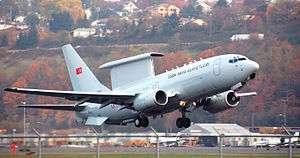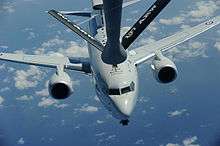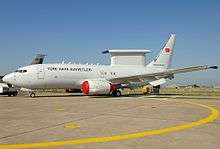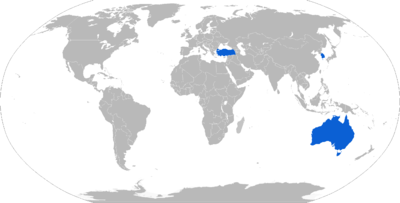Boeing 737 AEW&C
| Boeing 737 AEW&C E-7 Wedgetail | |
|---|---|
 | |
| Boeing 737 AEW&C built for the Turkish Air Force | |
| Role | Airborne early warning and control (AEW&C) |
| Manufacturer | Boeing |
| First flight | 2004 |
| Introduction | Early 2009[1] |
| Status | In use |
| Primary users | Royal Australian Air Force Turkish Air Force Republic of Korea Air Force |
| Number built | 14 |
| Developed from | Boeing 737 Next Generation |
The Boeing 737 AEW&C is a twin-engine airborne early warning and control aircraft. It is lighter than the 707-based Boeing E-3 Sentry, and mounts a fixed, active electronically scanned array radar antenna instead of a rotating one. It was designed for the Royal Australian Air Force (RAAF) under "Project Wedgetail" and designated E-7A Wedgetail.
The 737 AEW&C has also been selected by the Turkish Air Force (under "Project Peace Eagle", Turkish: Barış Kartalı) and the Republic of Korea Air Force ("Project Peace Eye", Korean: "피스 아이"), and has been proposed to Italy and the United Arab Emirates.
Design and development
In the 1990s, Australia began forming a need for an airborne early warning and control (AEW&C) aircraft. In 1996, Australia issued a request for proposal (RFP) for the aircraft for the RAAF under Project Wedgetail.[2] In 2000, Australia awarded Boeing Integrated Defense Systems a contract to supply four AEW&C aircraft with options for three additional aircraft.

The 737 AEW&C is based on Boeing Business Jet 1; a 737-700IGW airframe variant of the Boeing 737 Next Generation, roughly similar to the 737-700ER. The aircraft uses the Northrop Grumman Electronic Systems Multi-role Electronically Scanned Array (MESA) radar. The L-band (1 to 2 GHz) electronically scanned AEW and surveillance radar is located on a dorsal fin on top of the fuselage, dubbed the "top hat", and is designed for minimal aerodynamic effect. The radar is capable of simultaneous air and sea search, fighter control and area search, with a maximum range of over 600 km (look-up mode). When operating in look-down mode against fighter-sized target, the maximum range is in excess of 370 km. When used against maritime targets, the maximum range is over 240 km for frigate-sized targets. MESA is capable of simultaneously tracking 180 targets and conducting 24 intercepts. In addition, the radar antenna array is also doubled as an ELINT array, with a maximum range of over 850 km at 9,000 meter altitude.[3] The 10.8 m long by 3.4 m high antenna assembly incorporates 7.3 m long by 2.7 m high Side-Emitting Electronic Manifold array, with the top hat supporting array providing 120° coverage on port and starboard side, while the top hat array itself provides 60° fore and aft, thus providing a complete 360° coverage. The radar's beam can be set for a 2° to 8° width, while scan duration can be set from 3 s to 40 s. Radar signal processing equipment and central computer are installed directly below the antenna array.[4]
Other modifications include ventral fins to counterbalance the radar and countermeasures mounted on the nose, wingtips and tail. In-flight refueling is via a receptacle on top of the forward fuselage. The cabin features eight operator consoles with sufficient space for four more; the Australian fleet will operate ten consoles with space for two more (four on port side and six on the starboard side).[5] Northrop Grumman's MESA radar also formed the basis for the same company's Multi-Platform Radar Technology Insertion Program (MP-RTIP) which was developed for the United States Air Force's E-10 MC2A aircraft.
Operational history
Australia

Australia ordered four AEW&C aircraft with options for three additional aircraft. Australia has since taken up two of those options. Aircraft deliveries were to begin in 2006, but significant program delays due to integration problems have occurred. The first two Wedgetail aircraft were assembled and underwent testing in Seattle, Washington. The remaining aircraft are to be assembled by Boeing Australia.
For the Australian aircraft, Boeing and Northrop are teamed with Boeing Australia, and BAE Systems Australia. Boeing Australia will provide training, maintenance and support, BAE provides EWSP systems, Electronic Support Measures (ESM) systems and ground support systems.
On 29 June 2006 the Australian Minister for Defence, Brendan Nelson, announced that Boeing had recently informed the Australian Government that the Wedgetail project had fallen behind schedule. According to Nelson's press release, the company had previously maintained that the project was on schedule.[6] Boeing announced an 18-month delay, due to problems integrating radar and sensor computer systems, and was not expected to deliver the aircraft until early 2009. Additionally, Boeing took $770 million in charges in 2006 for the delayed aircraft.[7] Furthermore, on 20 June 2008 Boeing announced another delay to the Australian program, due primarily to integration of the radar and Electronic Support Measure (ESM) systems.[8]
On 16 March 2009 Boeing demonstrated control of three ScanEagle UAS from a Wedgetail AEW&C aircraft.[9]
On 26 November 2009 Boeing delivered the first two 737 AEW&C aircraft to the Royal Australian Air Force (RAAF).[10] Initially these aircraft remained Boeing owned and operated, then on 5 May 2010 the RAAF formally accepted these aircraft into service.[11] The RAAF accepted its sixth 737 AEW&C aircraft on 5 June 2012; this is the last of Wedgetail Australia had on order.[12] All Australian aircraft are to be operated by No. 2 Squadron RAAF and will be based at RAAF Base Williamtown with a permanent detachment at RAAF Base Tindal. In November 2012, Wedgetail aircraft achieved Initial Operational Capability.[13]
On 1 April 2014, the first operational sortie occurred with the air control of maritime patrol aircraft taking part in the search for Malaysia Airlines Flight 370 off the coast of Western Australia.
On 1 October 2014, a Wedgetail conducted the first Australian sortie over Iraq supporting coalition forces conducting airstrikes against the Islamic State of Iraq and the Levant (ISIL).[14] In January 2015, the Australian E-7A performed the longest Australian command and control mission in a war zone during a 16-hour, 18-minute combat mission over Iraq, requiring two air-to-air refueling to stay aloft. Australian Wedgetail crews routinely perform 13-hour missions.[15] In early April 2016, Rotation 5 of aircrew and maintenance personnel that had been operating the RAAF Wedgetail in the Middle East achieved a record 100 percent mission success rate in Coalition operations against Daesh. The E-7A successfully conducted all 36 missions, each lasting upwards of 12 hours, amounting to nearly 500 hours of flying for the one aircraft.[16]
On 26 May 2015, Australia's fleet of six E-7A Wedgetail airborne early warning & control (AEW&C) aircraft achieved final operational capability (FOC). This occurred after the aircraft supported search operations for MH370 and took part in Operation Okra, flying 1,200 hours during more than 100 sorties in the fight against ISIL.[17]
Turkey

Four Boeing 737 AEW&C Peace Eagle aircraft, along with ground support systems were ordered by the Turkish Air Force, with an option for two more. Turkish Aerospace Industries (TAI) is the primary subcontractor for the Peace Eagle parts production, aircraft modification, assembly and tests. Another Turkish subcontractor, Havelsan, is responsible for system analysis and software support besides the delivery of Ground Support Segment which will be located in Konya, Turkey.[18] HAVELSAN of Turkey is also the only foreign company licensed by the U.S. Government to receive critical source codes.[19]
Peace Eagle 1 is modified and tested by the Boeing Integrated Defense Systems in Seattle, Washington, USA. Peace Eagle 2, 3 and 4 are modified and tested at the facilities of TAI in Ankara, Turkey, with the participation of Boeing and a number of Turkish companies. In 2006, the four Peace Eagle aircraft were scheduled to be delivered in 2008.[20] In September 2007, Boeing completed the first test flight of Turkey's AEW&C 737.[21] On 4 June 2008, it was announced that the Turkish Aerospace Industries had completed modifications to Peace Eagle 2, the second 737 AEW&C aircraft at TAI's facilities in Turkey. Completion of checks on flight and mission systems took place in the third quarter of 2008.[22] In 2013, Israel responded to American pressure and delivered the EW equipment for the Turkish aircraft.[23]
The first Peace Eagle aircraft, named Kuzey (meaning North) was formally accepted into Turkish Air Force inventory on 21 February 2014.[24][25][26][27] The remaining three aircraft will be named Güney (South), Doğu (East) and Batı (West).[27]
South Korea
On November 7, 2006, Boeing won a $1.6 billion contract with South Korea to deliver four aircraft by 2012.[28] Boeing beat the other entrant, IAI Elta's Gulfstream G550-based aircraft, which was eliminated from the competition in August 2006.[29] The first Peace Eye aircraft was delivered to Gimhae Air Base, Busan for acceptance testing on August 1, 2011[30] with the remaining three aircraft delivered every six months until 2012.[31] The second aircraft was modified into an AEW&C configuration by Korea Aerospace Industries (KAI), then delivered to Gimhae Air Base on December 13, 2011.[32] After receiving AEW&C modifications by KAI, the third aircraft was delivered on May 17, 2012 to Gimhae Air Base.[33] The fourth aircraft was delivered on October 24, 2012.[34]
Potential customers
In 2004, the Italian Air Force was considering the purchase of a total of 14 Wedgetail and P-8 MMA aircraft, with aircraft support to be provided by Alitalia.[35]
The Boeing 737 Wedgetail is supposedly the favored competitor for the AEW&C program of the United Arab Emirates.[36]
Qatar has confirmed that it will purchase three 737 AEW&C aircraft.[37]
Operators

_Boeing_E-7A_Wedgetail_aerial_display_at_the_2015_Warbirds_Downunder_Airshow_at_Temora.jpg)
- Royal Australian Air Force – six aircraft in use. The type is designated "E-7A Wedgetail" by Australia.[38]
- Republic of Korea Air Force – four aircraft in use.[34] Republic of Korea Air Force is considering ordering 2-3 additional Peace Eye aircraft.[39]
- Turkish Air Force – four aircraft in use[40]
Specifications
Data from Boeing[41]
General characteristics
- Crew: six to ten
- Payload: 43,720 lb (19,830 kg)
- Length: 110 ft 4 in (33.6 m)
- Wingspan: 117 ft 2 in (35.8 m)
- Height: 41 ft 2 in (12.5 m)
- Wing area: 980 ft² (91 m²)
- Airfoil: B737D
- Empty weight: 102,750 lb (46,606 kg)
- Max. takeoff weight: 171,000 lb (77,564 kg)
- Powerplant: 2 × CFM International CFM56-7B27A turbofans, 27,000 lbf (118 kN) each
Performance
- Cruise speed: 530 mph (853 km/h)
- Range: 3,500 nmi (6,482 km)
- Service ceiling: 41,000 ft (12,500 m)
Avionics
See also
- Related development
- Aircraft of comparable role, configuration and era
References
- ↑ "Boeing announces further delay to Australia's Wedgetail aircraft" "Jane's Information Group" November 28, 2006 Archived February 28, 2007, at the Wayback Machine.
- ↑ "AIR 5077 - Project Wedgetail". Defence Materiel Organisation
- ↑ "Defense & Security Intelligence & Analysis: IHS Jane's - IHS". janes.com. Retrieved 7 March 2016.
- ↑ "Defense & Security Intelligence & Analysis: IHS Jane's - IHS". janes.com. Retrieved 7 March 2016.
- ↑ "Defense & Security Intelligence & Analysis: IHS Jane's - IHS". janes.com. Retrieved 7 March 2016.
- ↑ Nelson, Brendan "Wedgetail Project". Australian Minister for Defence press release. Archived August 27, 2006, at the Wayback Machine.
- ↑ "Radar down under Australia grapples with the Wedgetail AEW&C program". C4ISR Journal, 4 May 2007.
- ↑ "Minister Tours Wedgetail Facility at BAE Systems Australia". Australian DoD press release. Archived May 25, 2009, at the Wayback Machine.
- ↑ "Boeing Demonstrates Command and Control of ScanEagle UAS From Wedgetail AEW&C Aircraft". Boeing, 6 April 2009.
- ↑ "Boeing Delivers 2 Wedgetail AEW&C Aircraft to Royal Australian Air Force". Boeing, 26 November 2009.
- ↑ "Boeing Wedgetail Aircraft Accepted Into Royal Australian Air Force Fleet". Boeing, 5 May 2010.
- ↑ Waldron, Greg. "RAAF receives final Wedgetail AEW&C aircraft". Flight International, 5 June 2012.
- ↑ "Wedgetail AEW&C Aircraft has achieved IPC". airforceworld.com
- ↑ "Islamic State: Royal Australian Air Force planes complete first flights over Iraq as part of international coalition against 'apocalyptic death cult'". Australian Broadcasting Corporation. 2 October 2014. Retrieved 2 October 2014.
- ↑ Wedgetail Endurance Mission - Airforce.gov.au, 13 January 2015
- ↑ Air Task Group Wedgetail Achieves 100% Mission Success Rate in the Middle East - Defence.gov.au, 8 April 2016
- ↑ RAAF’s E-7A Wedgetails achieve FOC - Flightglobal.com, 26 May 2015
- ↑ Peace Eagle (PE) - Turkish Airborne Early Warning & Control System, Havelsan.
- ↑ "Team World". Boeing Frontier's magazine, August 2007.
- ↑ "Boeing Installs MESA Antenna on First Peace Eagle Aircraft". Boeing, March 2, 2006.
- ↑ "Boeing Successfully Completes First Test Flight of AEW&C Peace Eagle Aircraft", Boeing, September 6, 2007.
- ↑ "Boeing Supplier Turkish Aerospace Industries Completes 1st In-Country Modification of Peace Eagle AEW&C Aircraft". Boeing, June 4, 2008.
- ↑ "Israel sends Turks EW systems despite rift." spacedaily.com
- ↑ BEKDIL, BURAK EGE (8 February 2014). "Boeing Delivers 1st Spy Plane To Turkey; Faces Penalties". www.defensenews.com. Gannett Government Media. Retrieved 8 February 2014.
- ↑ "TSK yeni yıldızı Barış Kartalı'na kavuştu". Hürriyet, 21 February 2014.
- ↑ "Turkey takes delivery of military aircraft". Today's Zaman, 21 February 2014.
- 1 2 "First Airborne Early Warning & Control aircraft of the Peace Eagle Project, Kuzey (North) was taken into inventory". Turkish Air Force
- ↑ "South Korea picks Boeing for surveillance planes." Reuters. November 8, 2006.
- ↑ "S. Korea drops IAI, keeps Boeing in $2 bln plane deal." Reuters. August 3, 2006.
- ↑ "Korea gets 1st early warning aircraft". The Korea Times. August 1, 2011.
- ↑ "S. Korea to have 1st early warning aircraft". The Korea Times. March 2, 2011. Archived from the original on 2011-03-04.
- ↑ "Boeing Delivers 2nd Peace Eye AEW&C Aircraft to Republic of Korea Air Force, Boeing Defense". Boeing, December 13, 2011.
- ↑ "공군, 16일부로 피스아이 3대 보유". naver.com. Retrieved 7 March 2016.
- 1 2 Gary Parsons, Gary. "Boeing Delivers Final Peace Eye to Korea". Key Publishing via key.aero, October 31, 2012.
- ↑ "U.S. MMA Decision Reverberates in Italy". Aviation Week & Space Technology, June 21, 2004.
- ↑ "Northrop Grumman E-2D Back in Competition for UAEAF AEW Platform". February 22, 2007.
- ↑ Menon, Praveen (27 March 2014). "UPDATE 2-Qatar buys helicopters, missiles in $23 bln arms deals". Reuters.
- ↑ "RAAF’s Wedgetail Squadron marks history by celebrating battle honours". Australian Department of Defence, 30 November 2012.
- ↑ . 9 July 2013.
- ↑ "Turkey receives final Peace Eagle AEW&C platform". janes.com. Retrieved 28 December 2015.
- ↑ "737 Airborne Early Warning and Control" (PDF). Boeing. Archived from the original (PDF) on 29 June 2011. Retrieved 5 August 2011.
External links
| Boeing Advanced Early Warning and Control interior compartments and systems | |
|
| |
|
|
- Boeing 737 AEW&C page on Boeing.com
- RAAF E-7 Wedgetail page
- E-7A WEDGETAIL Airborne Early Warning & Control aircraft on airrecognition.com
| Wikimedia Commons has media related to Boeing 737 AEW&C. |